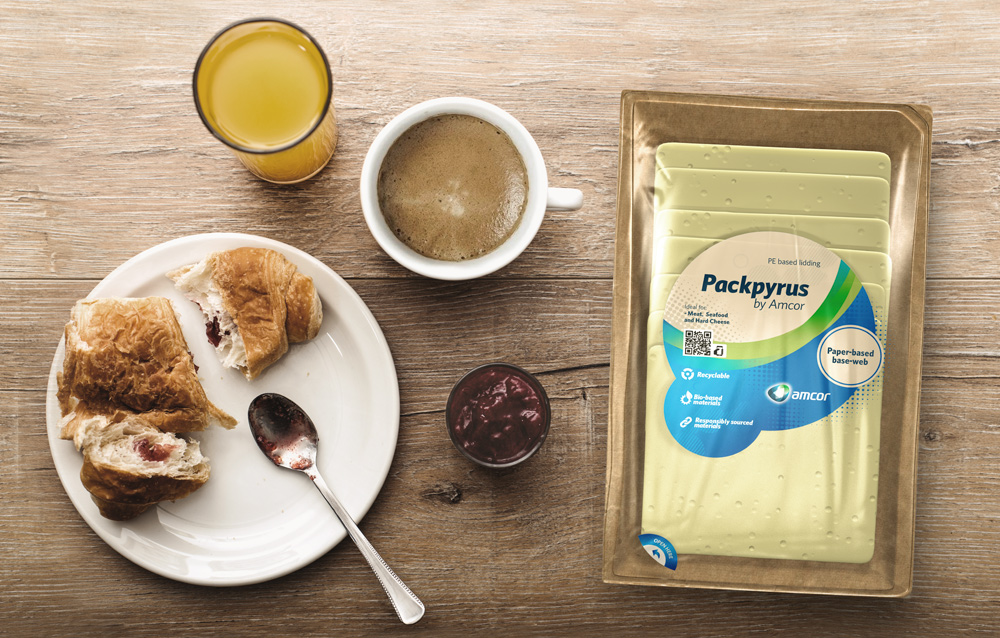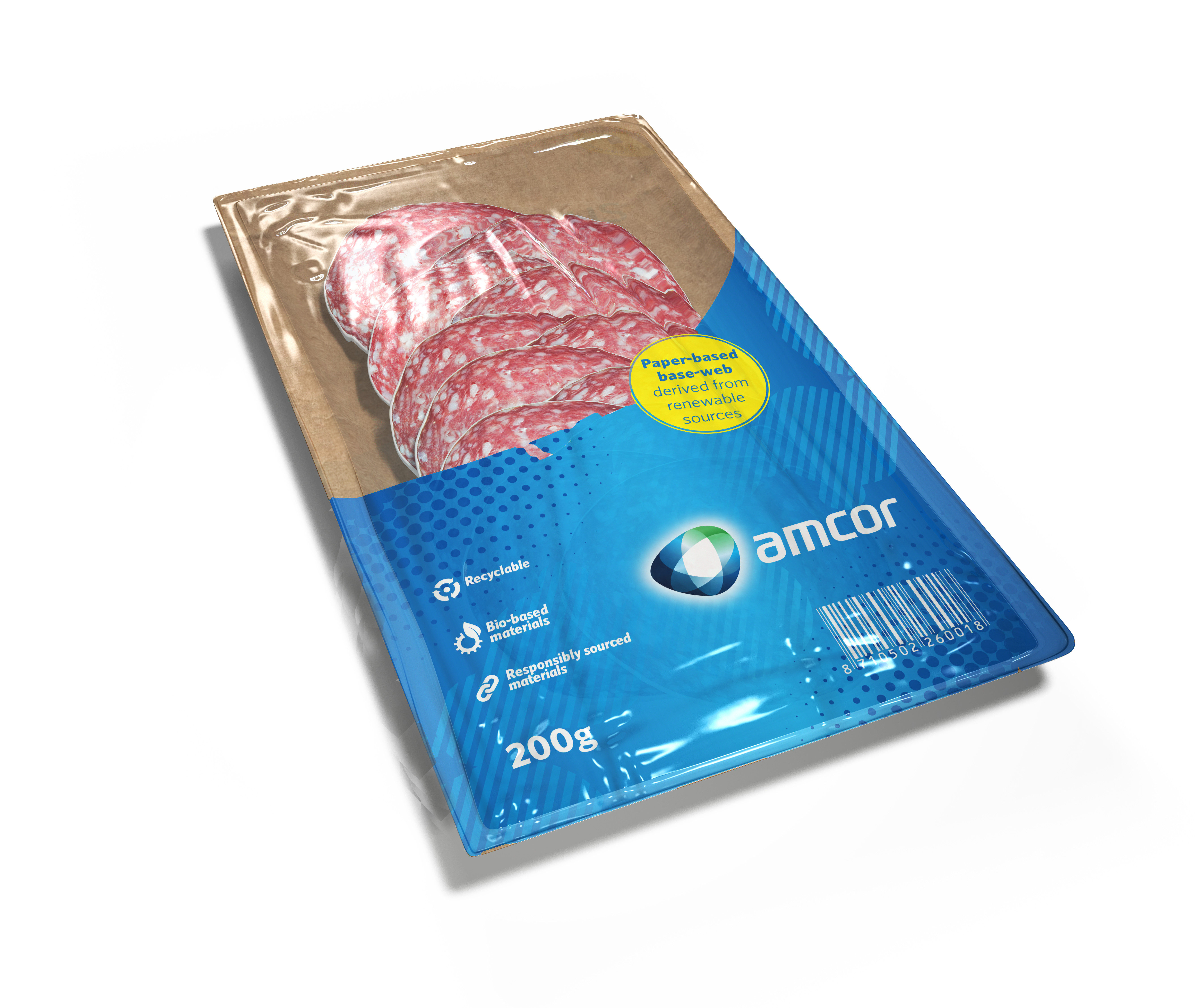Meet Packpyrus: Paper packaging for meat and cheese
Sustainability
November 2, 2020Reading time: 2 minutes
With consumers becoming more conscious of sustainability and recycling, it’s no wonder that paper and cardboard packaging have a natural appeal. But can these materials work for perishable foods like meat, fish, seafood and cheese? Rosalia Rosalinova tells us how Amcor’s Packpyrus offers a solution.
With consumers becoming more conscious of sustainability and recycling, it’s no wonder that paper and cardboard packaging have a natural appeal. But can these materials work for perishable foods like meat, fish, seafood and cheese? Rosalia Rosalinova tells us how Amcor’s Packpyrus offers a solution.

Paper can make for an excellent recyclable packaging choice when used appropriately. When derived from a sustainable source, paper represents the circular economy in action: originating from trees, harvested to create paper and recycled to be used again.
Our recent research into consumers’ sustainability preferences shows that people are becoming more conscious about their packaging choices – in fact, 83% say they check on-pack instructions to know how to dispose of packaging correctly.
Offering a more sustainable packaging solution is an excellent way to connect with sustainability-conscious consumers and demonstrate your brand’s commitment to environmental goals.
Thinking out of the box with paper-based packaging for fresh food
While paper-based packaging is already used for dry goods that don’t require a barrier, such as pasta, it’s not always thought of for perishables such as meat, seafood and cheese. Because these foods spoil quickly, packaging must undergo rigorous safety testing to ensure the product maintains freshness.
However, meat and cheese producers should not have to miss out on the benefits of paper-based packaging. This is why we created Packpyrus.

“Packpyrus is also eye-catching on shelf with its artisanal and authentic look, it naturally appeals to consumers looking for environmentally sustainable packaging. Packpyrus can also be thermoformed on existing packaging lines, which makes it easy to work with on our machines.” – Philippe De Waele, Category Buyer Packaging from Ter Beke Fresh Food Group
With Packpyrus, we thought about what the modern-day consumer wants from their meat and cheese packaging. We know that paper-based packaging scores highly in consumer perceptions around sustainability. But we also know that consumers want packaging that will keep in freshness.
__What is Packpyrus? __
Packpyrus is a thermoformable paper-based bottom web that can be combined with two different lidding solutions:
Option 1: Lidding barrier film for modified atmosphere packaging (MAP) applications. A recyclable version of this lidding is available.
Option 2: SkinTite skin film offers unrivalled product presentation, increased durability and flavour enhancement. A recyclable version of this lidding is also available.
Recyclable in practice in countries where collection and polyolefin recycling streams exist. For information on recyclability in your market, our packaging experts can advise you.

More sustainable
Packpyrus base-web delivers a 52% reduction in non-renewable primary energy and a 56% reduction in carbon footprint compared to traditional plastic APET/PE tray.
__Renewably sourced __
Packpyrus’ paper laminate contains at least 85% paper fibers from FSC® certified sources, replacing the classic and non-recyclable APET/PE bottom webs. This means that Packpyrus can be sorted in certain paper streams and contributes to the production of recycled paper.
Stand out from the crowd
In the sliced meat or cheese aisle, you only have a short time to grab the consumer’s attention – shelf appeal counts. Packpyrus stands out with its artisanal ‘kraft paper’ look and feel.
To find out more about Packpyrus, click here or talk to one of our team members. Click to see more packaging solutions for meat, fish and seafood, or discover a range of dairy packaging soltuions.
Related read: Find out more about consumer perceptions and behavior related to packaging in our new report: It’s a Wrap: The future of packaging is all about sustainability here
Related Insights
Smoothly confident - A fresh take on soft cheese packaging
September 10, 2020
Product story, health benefits, dietary options and sustainability are all important factors in dairy purchase decisions. Soft cheese producers can use packaging to be at the forefront of these trends and offer a more pleasurable consumption experience. With Matrix – a premium paper-based packaging that's paraffin-free – it is possible to improve the taste, shelf life, and packaging recyclability...
Product story, health benefits, dietary options and sustainability are all important factors in dairy purchase decisions. Soft cheese producers can use packaging to be at the forefront of these trends and offer a more pleasurable consumption experience. With Matrix – a premium paper-based packaging that's paraffin-free – it is possible to improve the taste, shelf life, and packaging recyclability...
SkinNova™: Skin packaging with 70% less plastic
July 27, 2020
Finding packaging that minimizes carbon footprint and extends the shelf life of protein such as fresh fish is a challenge. Here’s how a leading Italian retailer achieved both with SkinNova™ – more sustainable skin packaging that reduces plastic waste by 70%*.
Finding packaging that minimizes carbon footprint and extends the shelf life of protein such as fresh fish is a challenge. Here’s how a leading Italian retailer achieved both with SkinNova™ – more sustainable skin packaging that reduces plastic waste by 70%*.
Thrill of the Grill: Barbecue packaging insights for the new season
June 4, 2021
As the weather heats up in the northern hemisphere, people want to get together outside to enjoy the beautiful flavours of cooking over fire. So how can brands use bbq packaging to tempt people to fire up their grills, set out a picnic and get cooking?
As the weather heats up in the northern hemisphere, people want to get together outside to enjoy the beautiful flavours of cooking over fire. So how can brands use bbq packaging to tempt people to fire up their grills, set out a picnic and get cooking?
